Finding your artistic expression is like discovering a hidden fingerprint. Your uniqueness is there, but it takes time and persistence to unveil. Artists who appear to have unique styles will admit to drawing hundreds or thousands of uninteresting sketches until patterns appeared. They freely took from influences, tried methods that failed horribly, and occasionally found something that worked. That amazing moment when your hand creates something uniquely yours? Not one inspiration, but showing up at the blank page, curious and eager to fail. The trip is frustrating and rewarding, yet your visual stamp is hidden within the lines.
Exploring Different Drawing Techniques
Think about visual language drawing. Expressions are unique to each. Gentle gray pencil murmurs, catching face light. Due to its sharp lines, ink demands careful marking. Nothing rivals graphite’s tactile scritch, yet digital tools let you explore without paper. Sketch contours without looking at paper. Try photo-realism till your hand hurts. Scribble carelessly like a kid. Feeling-bad methods provide vital lessons. That charcoal landscape smudged? Pressure and paper texture were new to you. Crazy-off-proportion architecture drawing? A perspective masterclass. Without bias, switch between cartoons and meticulously drawn still-lifes. Even seemingly unconnected tests reveal your own connections.
Finding Inspiration and Influences
Conversation inspires. Vary your images. Explore classical works, street art, scientific photographs, children’s books, and ethnographic textiles. That obscure 1970s Soviet animation studio may inspire something surprising. Botanical illustrations in that old library book may answer your compositional problem. Keep photos that stop scrolling in a folder. Why am I here? The color relationship? Line quality? A mood? Museum visits help, but everyday inspirations important. Shadows on your kitchen floor. How cats fold into unfathomable forms. Strange radio tower architecture on your commute. Music, literature, and science can inspire unexpected visual interpretations. How you consume and assimilate factors shapes your worldview.
Experimenting with Different Mediums
Different mediums whisper possibilities. Watercolor pools and blossoms teach resignation and strategic planning. Butter-thick oil pastel strokes merge under your fingertips. Gouache’s matte finish enhances graphics. Developing artists benefit and suffer from digital technologies’ limitless undo. Give each medium ample time to expose its peculiarities and possibilities. Mixed-media approaches—a ballpoint pen and brilliant watercolor washes—often generate breakthroughs. Colored pencil on collage. Covering coffee stains. Most interesting discoveries are made with “wrong” materials: erasers instead of pencils, cosmetics brushes for blending, and ink-dipped twigs. More important than technical proficiency is playful experimenting. If you get past the awkward learning phase, your least favorite medium could become your signature.
Practicing Consistently and Reflecting on Your Work
Consistent practice takes mindfulness, not just hours. Twenty minutes of focused drawing trumps two hours of distraction. Lifecycle sustainability. Mornings before work? Lunchtime sketches in 10 minutes? Sanctify whatever works. The sketchbook—a visual thought lab—may be the most important style tool. Enter dates. Record happy and bad feelings. Track patterns over months. Review old work—breakthroughs may be in pages you ignored months ago. Limit your exploration. Draw the same thing 50 ways. Focus on three colors for a month. Only work at thumbnail size, then scale. Be selective when seeking advice—some work, some don’t. Trust your instincts and seek help. Please note that “finding your style” is continuous. Discover fresh terrain when you believe you’ve found it.
Practice and play are needed to create unique art. It demands technical training and daring experimentation. Your visual style evolves through continuous touch with your craft’s essential elements, including handwriting. Surprise breakthroughs are rare; you’ll find something distinctive in your work later. This quest requires patience and innovative instincts. Accepting several sources and finding your own voice creates a real artistic voice. While not original (nothing is), it represents your distinct worldview.
Photo Attribution:
1st & featured image by https://www.pexels.com/photo/close-up-of-a-drawing-6714357/
2nd image by https://www.pexels.com/photo/close-up-shot-of-paintbrushes-on-a-mug-7257153/

